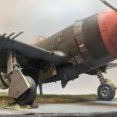Search the Community
Showing results for tags 'tbf-1'.
-
Hello, everyone. This is my completed vignette that I’m calling, “The Avengers of Guadalcanal.” During the long, grueling campaign for the Solomon Islands, Allied and Japanese forces threw themselves at each other for months. Pitched night naval battles, furious aerial melees, and bitter ground combat were the brutal hallmarks of what I feel was truly the turning point in the Pacific War. By November 1942, American forces were desperately holding on to Henderson Field on Guadalcanal in an effort to keep the Cactus Air Force flying. One of the many units fed into the grinder was Marine Scout Bombing Squadron 131 (VMSB-131) whose men, along with countless others, flew and fought to the point of exhaustion. In their new TBF-1 Avenger torpedo bombers, they attacked Japanese supply vessels and warships (the vaunted “Tokyo Express”) and helped turn the tide of the Guadalcanal campaign in the Allies’ favor. This vignette is a small tribute to all those who fought and paid the price for freedom in those dark days of 1942. It is my first real attempt at a diorama in any scale or subject and I learned a lot valuable lessons for the next time. I also worked to push the limits of my skills, adding a few things that I’d never done before. The Materials This is Trumpeter’s TBF-1C kit (02233) that I backdated to represent a very early TBF-1. While the changes are subtle, they are numerous. To accomplish this, I had to · Cut the trough in the cowl and cowl flap to accommodate the forward-firing .30cal machine gun · Fill the holes for the .50s in the leading edges of both wings · Fill the access panels in the wings for the .50s · Fill the ammo panels in the wings for the .50s. · Scratch build a radio antenna mast that was raked aft at an angle · Remove the pads for the rocket rails on the underwings · Fill the holes for the rocket rails on the underwings · Scratchbuild many (now invisible) interior parts that were only found on TBF-1s I used the Eduard interior detail kit and a set of resin wheels that came with the kit when I bought it from a fellow LSP forum member years ago. Sadly, as this kit had been passed around a few times, many of the parts had been broken in shipping, so I had to spend some time repairing them or scratch building replacements. The base is polystyrene board framed with stained pine strips. The text plate is from PlaqueMakers.com. The Figures The figures are from several sources. · The two standing figures are from Black Dog Resin. They’re a little large and come out to about 6’5” in 1/32 scale. · The kneeling crewman inspecting the tail gear assembly is a 3D printed figure from Reedoak (highly recommended). · The ground crewman in the cockpit is the Aires tow truck driver. He had some fairly major surgery to fit the Avenger’s cockpit. His clipboard and checklist are scratch built of plastic stock and spare PE. The Finish Paints are a mix of MRP, Tamiya, and Vallejo with most weathering done by oils, Mig washes, and pastels. Chipping was kept to a bare minimum, because I figure in November 1942, there was no such thing as an "old" TBF-1 Avenger. Dirt, grime, and wear were applied... erm... liberally. The Surprise Just wait and see. The Build A few months ago, I came across this picture and fell in love: The oil staining on the cowl, goofy “6” digit on the under cowl, muck on the belly and landing gear, stained prop, 2-tone prop tips, and bald tires all cried out to be built. Unfortunately, no one makes a 1/32 TBF-1, so I sucked it up and decided to take on the task of scratch-back dating it. In my many references that I acquired for this build, I came across this picture as well, where the flight crews prepared for the mission while ground crewman warmed the engine. … and thus the idea of the vignette was born. And finally… On to the show: And now the surprise: "CLEAR PROP!" The kit is hand-wired with 9 lights and an electric motor to spin the propeller. Each wing has a pair of position lights in addition to another in the rudder. There's a formation light on the top of the spine aft of the turret, and three interior cockpit lights. The motor is a brushless drone motor and all are wired in parallel through the side-mounted switch to a 4.5v battery pack glued to the bottom of the foam board. Having never done electronics before, this was a big challenge for me. If I do it again, I'll find a different motor as this one builds up too much heat and therefore limits the run time. Live and learn. It's nearly impossible to see now, but the interior is extensively detailed throughout. Scratchbuilding plus the Eduard detail kit went a long way to make the interior look like a TBF-1. The oil staining here was done with Abteilung 502 "Engine Grease" oil paints and Migs "Fuel stains" weathering "wash." I am convinced it is actually used motor oil. I've been around enough airplane and car engine in my life to know the smell. The trough for the forward-firing .30 cal found on TBF-1s was the most challenging part of the backdate process. I took some spare photoetch sheet and bent it into a U shape. After cutting out the panel and studying reference pictures, I shaped and test fit the piece about a thousand times until it looked about right. The turret was extensively detailed through reference photos. Electrical cabling, placards, seatbelts, and other scratch pieces were added to enhance the increased detail from the Eduard kit. Insignia and numerical stencils were done on my Silhouette Cameo cutter. Smaller stencils are kit decals.



